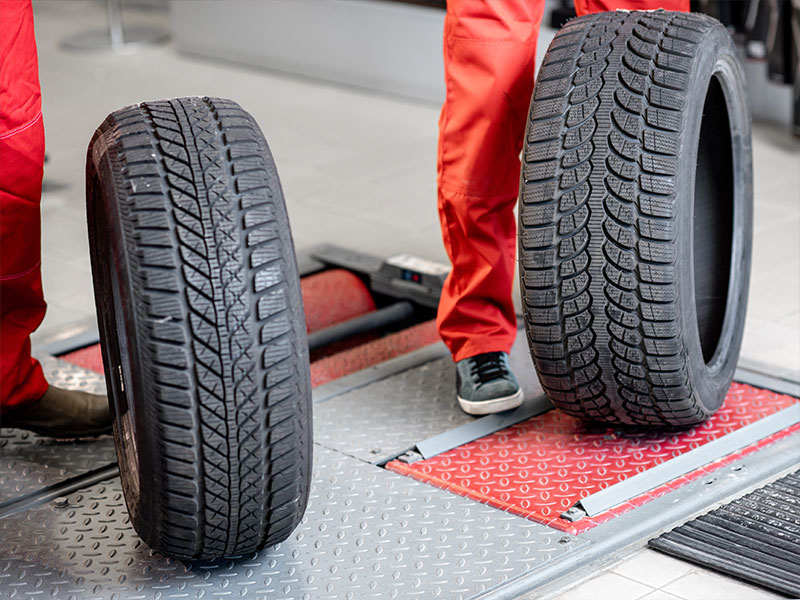Tire rotation is important for safety, extending the life of your tires, and maintaining the manufacturer’s warranty.
Is It OK To Rotate Tires Side to Side
Most of the time it is acceptable to rotate your tires side to side, but it is not ideal.
The benefits of this rotation pattern are minimal and will only help with tire wear inconsistencies between sides. Tire rotation patterns that involve front to rear changes are much more beneficial.
The only time you shouldn’t rotate your tires this way is if you have directional tires installed on your car or truck. Directional tires require that the tire spin in a certain direction. Switching sides will reverse the direction of spin.
The primary reason tires are rotated from side to side is because the car or truck has staggered tires which prevent rotating front to back.
By rotating tires from one position on your vehicle to another, you will hopefully more evenly distribute the tire wear. A tire in a specific position on a car or truck will tend to wear in a unique way. If moved to a different position, the wear will be different.
Let’s cover the pros, cons, and details of the side to side rotation pattern and when it should or should not be used.
Does Rotating Tires Side To Side Help?
Some tire rotation is better than no tire rotation at all. When rotating tires from one side of your vehicle to the other at the same end, you don’t change the wear pattern very much.
Your left front tire and right front tire will wear very similarly. Switching these tires will even out inconsistencies in wear between the two sides but they will still wear very similarly.
For instance, rear wheel drive sports cars, which are a common type of vehicle to have a staggered wheel set that can only be rotated side to side.
These sports cars tend to have rear tires that wear more on their inner edges and very little on the outside. Rotating the rear tires from one side to the other will not change how much they wear on the outer edge versus inner edge.
Moving one tire from one side to the other will do little to move wear to the more unused side of the tire. You’re better off flipping the tire on the rim if you have the option. This will be extremely effective on a staggered tire vehicle.
Effects Of Rotating Tires Side To Side
- Helps even wear pattern inconsistencies between sides of the vehicle
- Isn’t much better than not rotating your tires at all
- Doesn’t shift the contact patch to less worn tread
- Directional tires can’t be rotated from one side to the other
While I recommend always rotating your tires enough to maintain the tire warranty, side-to-side rotation is not as effective as front-to-back.
TireGrades Expert Tip
When Is It OK To Rotate Tires Side To Side?
The following are some common situations that car owners can become confused about whether it is safe to rotate a tire from one side to another.
Let’s sort them each out.
Can You Rotate Directional Tires Side To Side?
Directional tires can not be rotated side to side. When a directional tire is mounted on the rim and put on one side or the other of your car or truck, it must stay on that side of the vehicle.
Directional tires are designed to work by spinning in only one direction. Moving them to the other side of your car will reverse the direction of spin.
The only way to safely move a directional tire from one side to the other would be to remove the tire from the rim, flip it around, and remount it.
Directional tires have an arrow that shows the intended direction of spin embossed on the sidewall. Always be sure that the directional arrow is pointing toward the front of your vehicle.
Directional Tire Example
Can You Rotate Front Tires Side To Side?
Front wheel drive vehicles will benefit more from rotating tires from one side to the other than not rotating them. But as with any sideways rotation pattern, there is little benefit.
There are times you can not rotate your tires from one side to the other. Directional tires must rotate in a specific direction. This means that the side that directional tires are mounted on is the side of the vehicle they must remain on.
Can You Rotate Asymmetrical Radial Tires Side To Side?
Asymmetrical radial tires can be rotated following any rotation patterns that normal tires can be rotated, including from one side to the other.
Asymmetrical tires simply need to be mounted on your wheel with a specific side of the tire facing outward. Once the tire is mounted properly on the rim, it can be moved to any position without any problem.
Always ensure that the sidewall has the word “Outside” embossed on the side that is visible when mounted on your car or truck.
Asymmetrical Tire Example
What Are Staggered Tires?
Staggered tires or wheels refers to having a different width or size wheel or tire on the front versus the rear of your vehicle. For instance, it’s common for some sports cars to have staggered tires.
The purpose of staggered tires is to increase traction of rear wheel drive vehicles. Wider tires are placed on the rear axle to increase the size of the contact patch and provide more grip. This helps prevent wheel spin during aggressive acceleration.
Another benefit of staggered tires is the wider rear contact patch helps prevent oversteer during hard cornering. The larger contact patch increases cornering traction at the rear tires. This is also beneficial to rear wheel drive vehicles which have a tendency to oversteer in turns when accelerating.
Staggered Tire Example
The rim on the rear has a much wider lip to accept the wider rear tires.

Staggered Tire Rotation
Staggered tires can only be rotated side to side since the larger tires need to be kept in the rear and the smaller tires need to be kept in the front.
Unfortunately, a side to side rotation pattern has little benefit but it is better than if you don’t rotate your tires at all.
The only other option for owners of cars with staggered wheels is to flip the tires on the rim. This involves removing the tires and remounting them with the sidewall that was facing inside now facing outward.
This is obviously more expensive and time consuming that a simple tire rotation, but is money well spent. Not all cars or trucks with staggered tires can do this however.
Often, sports cars or sports SUVs will have tires with asymmetrical tread patterns. This means that the tread must rotate in one direction and can’t be flipped on the rim as there is only one way the tire can be mounted.
What Is The Best tire Rotation Pattern?
There is no one “best” tire rotation pattern. Tire rotation patterns vary from one car or truck to the next. The best rotation pattern depends various factors.
One of the most significant is whether you have a front wheel drive, rear wheel drive, all wheel drive, or four wheel drive vehicle.
Staggered wheels and directional tires also play a role in what rotation patterns are acceptable and effective.
You can learn more about tire rotation in our article on “What Is Tire Rotation“.
Does It Matter Which Way You Rotate Your Tires?
The rotation pattern used when rotating your tires can have a dramatic effect on the benefits of the rotation. Rotating tires improperly can even be dangerous in some situations.
The best pattern to use will depend largely on the axle that drives your wheels.
The following are the most common tire rotation patterns, however there are some instances where these patterns may not be recommended based on your unique circumstances.
Forward Cross
A front wheel drive vehicle usually benefits most from the forward cross pattern.
Rearward Cross
Rear wheel drive vehicles will benefit most from the rearward cross pattern. All wheel drive vehicles also usually benefit most from the rearward cross pattern.
X-Pattern
A tire rotation pattern that works well regardless of drive axle is the X-pattern of rotation.
The most common limiting factors that would make these rotation patterns inappropriate are staggered tires or directional tires.
Final Thoughts
Tire rotation is important to extend tire life, ensure safety, and preserve your tire manufacturer’s warranty. It’s also important that rotation be done in a manner that is most effective. Side to side tire rotation is one of the least effective methods of rotating tires, but it is the only effective rotation pattern for staggered tires.
Directional tires should never be rotated side to side. Directional tires should only spin in one direction which prevents moving a directional tire to the other side of the vehicle.
Resources
Below are some links you may find helpful when learning about tires







